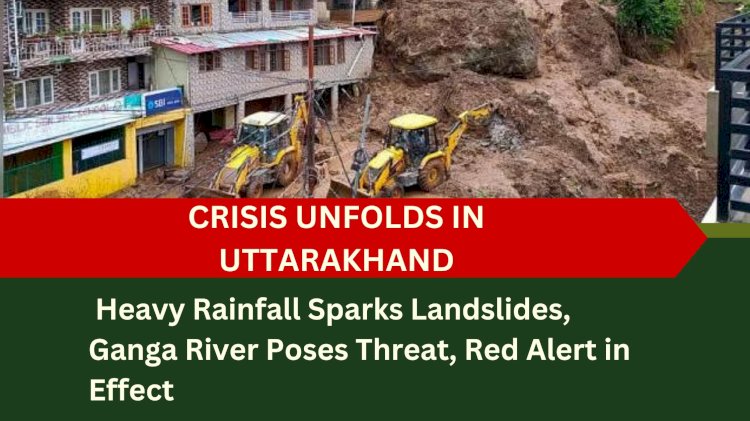Crisis Unfolds in Uttarakhand: Heavy Rainfall Sparks Landslides, Ganga River Poses Threat, Red Alert in Effect
Uttarakhand is currently facing a severe crisis due to heavy rainfall, leading to landslides, breaches in the Ganga River, and red alerts in several districts. Landslides pose a threat to lives and infrastructure, with road blockages and difficulty in rescue operations. The Ganga River breaching the danger mark has caused flooding and endangered riparian communities. The issuance of red alerts in Dehradun, Tehri, Pauri, and Haridwar districts calls for immediate action. The government is working on rescue and evacuation efforts, setting up relief camps, reinforcing embankments, and restoring normalcy. All stakeholders must collaborate and implement both immediate and long-term measures to mitigate the impact of the calamity and build a more resilient Uttarakhand.
By Shreya Rajvanshi Gangal

Introduction
Uttarakhand, a picturesque state in northern India, is currently facing a severe crisis as heavy rainfall triggers landslides, breaches in the Ganga river, and the issuance of red alerts in several districts. The incessant downpour has led to a threat to lives, property, and infrastructure, necessitating immediate attention and response. In this report, we will provide a comprehensive overview of the current situation in Uttarakhand, focusing on the landslides, breaches in the Ganga river, and the districts affected by the red alert – Dehradun, Tehri, Pauri, and Haridwar. It is crucial to understand the gravity of the situation and the need for prompt action to mitigate the impact of this natural calamity.
Landslides: A Looming Threat
Uttarakhand is known for its hilly terrain, making it susceptible to landslides during heavy rainfall. The recent spell of incessant rains has triggered numerous landslides across the state, posing a significant threat to both human lives and infrastructure. The continuous movement of loose soil and rocks has resulted in road blockages, hampering transportation and rescue operations. Remote areas have been particularly affected, with many villages cut off from the outside world.
The state government, along with the National Disaster Response Force (NDRF) and local authorities, is working tirelessly to clear the blocked roads and rescue stranded individuals. Evacuation efforts are also underway to relocate people from high-risk areas to safer locations. However, the unpredictable nature of landslides and the challenging terrain make these rescue operations arduous and time-consuming.
Ganga Breaches Danger Mark: Threat to Riparian Communities
The Ganga River, a lifeline for millions of people residing along its banks, is facing a critical situation as it breaches the danger mark due to the heavy rainfall. The rising water levels have led to flooding in low-lying areas, posing a threat to riparian communities and their livelihoods. The floodwaters have inundated agricultural fields, homes, and public infrastructure, exacerbating the impact of the ongoing crisis.
The state government and disaster management authorities are closely monitoring the situation and have set up relief camps to provide shelter, food, and medical assistance to those affected by the floods. Efforts are also underway to reinforce embankments and control the flow of water to mitigate further damage. However, the situation remains precarious, and constant vigilance is necessary to prevent the loss of life and property.
Red Alert: Urgent Action Required
The severity of the situation has prompted authorities to issue a red alert in four districts of Uttarakhand – Dehradun, Tehri, Pauri, and Haridwar. A red alert signifies the highest level of warning and calls for immediate action to ensure the safety of the population. People living in these districts have been advised to remain cautious, evacuate if necessary, and follow the instructions of local authorities.
Schools, colleges, and other educational institutions in the affected districts have been temporarily closed to ensure the safety of students and staff. Transportation services have also been disrupted, with road and rail connectivity severely impacted. The state government is working in close coordination with the concerned departments to restore normalcy and provide necessary support to the affected regions.
Conclusion
The current situation in Uttarakhand demands urgent attention and a collective response from all stakeholders. The landslides, breaches in the Ganga river, and the red alerts in Dehradun, Tehri, Pauri, and Haridwar districts pose a serious threat to the lives, property, and infrastructure of the affected regions. It is crucial for the government, disaster management authorities, and the public to work together to ensure the safety of those at risk.
Immediate measures, such as swift rescue operations, evacuation efforts, and the provision of essential services, should be prioritized. Additionally, long-term strategies, such as strengthening infrastructure, implementing effective early warning systems, and promoting sustainable land use practices, are essential to mitigate the impact of future natural calamities.
Uttarakhand's resilience in the face of adversity has been tested before, and it is through unity, determination, and prompt action that the state can overcome this crisis. The support and solidarity of neighbouring states, as well as the central government, are crucial in facilitating the restoration and recovery process. Together, we can work towards minimizing the impact of the ongoing disaster and building a more resilient Uttarakhand for the future.
What's Your Reaction?



















